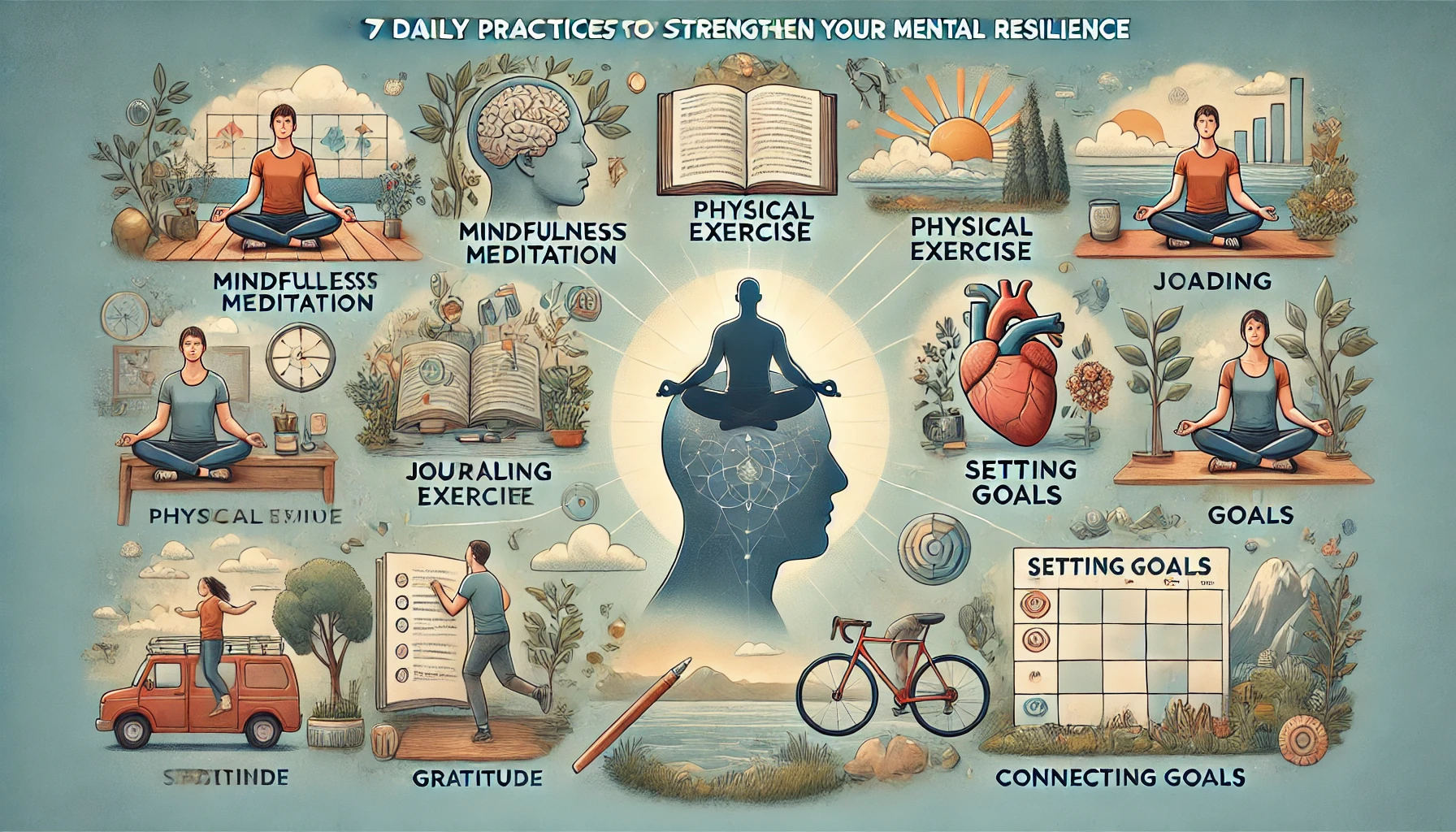Mental resilience is the ability to adapt, recover, and stay strong in the face of challenges. It’s not about avoiding difficulties but about training your mind to handle stress, setbacks, and uncertainty with confidence.
The good news? Resilience is a skill that can be developed through intentional daily practices. By incorporating these habits into your routine, you can train your brain to stay calm under pressure, bounce back from failures, and maintain a positive mindset even in difficult times.
This article explores seven powerful daily practices that strengthen mental resilience and help you stay focused, motivated, and emotionally stable.
1. Practice Mindful Awareness to Regulate Stress
Mindfulness helps you stay present, reduce emotional reactivity, and improve stress management. By focusing on the present moment, you can train your brain to respond thoughtfully rather than react impulsively to challenges.
How to Apply It:
- Start your morning with 5 minutes of deep breathing or mindful meditation.
- Use the “Pause and Observe” technique—before reacting to a stressful event, pause for a few seconds and observe your emotions.
- Engage in daily mindful activities like walking, eating, or journaling without distractions.
📌 Example: Studies show that daily mindfulness practice strengthens the prefrontal cortex, improving emotional regulation and reducing stress responses.
2. Reframe Negative Thoughts into Growth Opportunities
Your thought patterns shape your resilience. Resilient people reframe setbacks as opportunities for growth rather than failures.
How to Apply It:
- When facing a challenge, ask: “What can I learn from this?” instead of “Why is this happening to me?”
- Replace self-criticism with constructive self-talk (“This is tough, but I can handle it.”).
- Keep a gratitude journal—list three things you learned from challenges each day.
📌 Example: Neuroscience research shows that positive reframing rewires the brain for resilience, making you less likely to feel overwhelmed by stress.
3. Train Your Brain with Small Daily Discomforts
Resilience grows when you practice handling discomfort in controlled ways. By exposing yourself to manageable challenges, your brain learns to handle stress more effectively.
How to Apply It:
- Take cold showers to train your nervous system to tolerate discomfort.
- Do one thing that challenges you daily (e.g., start a conversation with a stranger, try a difficult workout).
- Practice delayed gratification—wait 10 minutes before giving in to an impulse (e.g., checking your phone, eating a snack).
📌 Example: Research shows that exposure to small stressors helps the brain adapt to larger challenges over time, making you mentally tougher.
4. Strengthen Emotional Control with Breathwork
Your breathing directly affects your nervous system. By controlling your breath, you can reduce anxiety, improve focus, and stay calm under pressure.
How to Apply It:
- Box Breathing: Inhale for 4 seconds → Hold for 4 seconds → Exhale for 4 seconds → Hold for 4 seconds.
- 4-7-8 Breathing: Inhale for 4 seconds → Hold for 7 seconds → Exhale for 8 seconds.
- Physiological Sigh: Take one deep inhale, then a second short inhale, followed by a long exhale.
📌 Example: Navy SEALs use breathing techniques to stay calm in high-stress situations, improving decision-making under pressure.
5. Build Mental Endurance with Physical Activity
Regular exercise not only strengthens the body but also builds mental resilience. Physical challenges train your brain to handle discomfort, increase discipline, and reduce stress hormones.
How to Apply It:
- Engage in at least 20-30 minutes of exercise daily (walking, running, strength training, yoga).
- Use exercise as stress relief—after a tough day, go for a walk instead of scrolling on your phone.
- Challenge yourself with high-intensity or endurance-based activities to train both mental and physical resilience.
📌 Example: A study from Harvard found that exercise increases brain-derived neurotrophic factor (BDNF), which improves stress resilience and mental toughness.
6. Develop a Stronger Mindset with Journaling
Journaling helps you process emotions, track progress, and build self-awareness, which are crucial for resilience.
How to Apply It:
- Write one lesson you learned each day from challenges.
- Track your emotional responses to stress and analyze patterns.
- Use prompt-based journaling: “How did I handle stress today? What can I do better?”
📌 Example: Research shows that journaling strengthens self-reflection and emotional regulation, making it easier to cope with difficult situations.
7. Strengthen Your Support System and Seek Perspective
Social connections play a critical role in mental resilience. Having a strong support system helps you gain perspective, receive encouragement, and navigate challenges more effectively.
How to Apply It:
- Surround yourself with positive, resilient people who reinforce a strong mindset.
- Seek advice from mentors or peers when facing obstacles.
- Practice active listening and empathy in conversations, strengthening emotional intelligence.
📌 Example: Studies show that people with strong social connections recover faster from stress and are more resilient in the face of adversity.
Final Thought: Train Your Mind for Unshakable Resilience
Resilience isn’t something you’re born with—it’s something you build through intentional daily practices. By incorporating mindfulness, breathwork, cognitive training, and physical challenges, you can strengthen your ability to stay strong, focused, and adaptable in any situation.
✅ Use mindfulness and breathwork to regulate stress in real time.
✅ Reframe challenges as opportunities for growth.
✅ Strengthen resilience through small discomforts, physical activity, and journaling.
Start today: Pick one resilience-building practice from this list and commit to doing it daily—you’ll soon notice a stronger, more adaptable mindset! 🚀












Leave a Reply